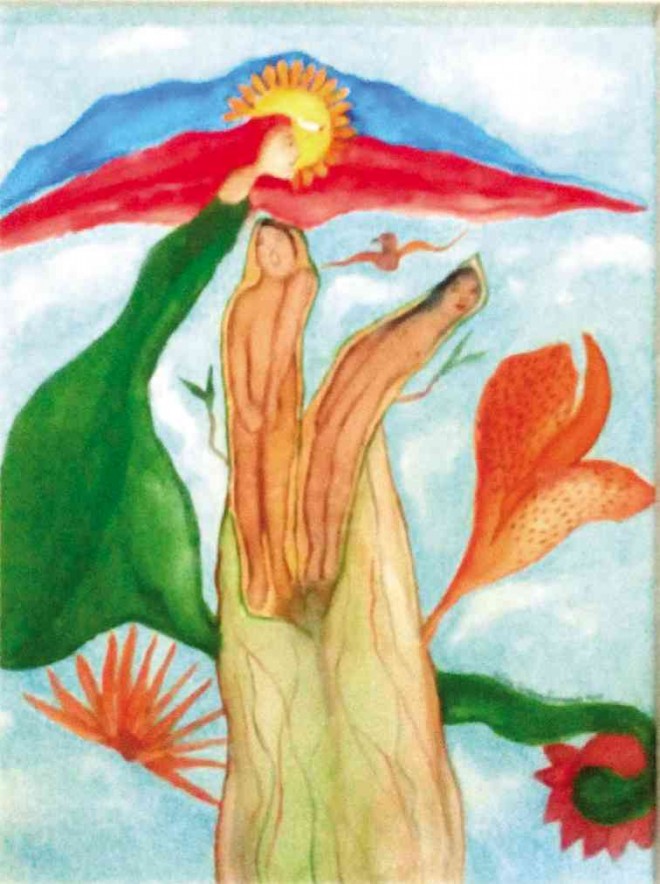
WHAT foreigner said that we are “dust and unto dust returnest?”
Wrong! We are Pinoys, we are not made of earth. We are putok sa buho, our first parents came from a bamboo. A piece of bamboo that had been washed to the shore and kept hitting the feet of a bird.
The bird got so sore he pecked and pecked at the bamboo until it split open. Behold—our first parents! The two creatures had no parents (except God). And since then, serious rumormongers have unfairly called children out of wedlock “putok sa buho” (fatherless).
Like a giant ‘suman’
Some time in my younger life, I fancied being buried like Filipinos of old, rolled up in a big mat like a giant suman. In the ’70s I was selling huge magnificent mats in Junque, my antique/folk art shop in Ermita. They were double family mats—room size, with abstract designs in bright colors.
The mats were from Laminusa in Sulu (now still a second class municipality of Siasi). It had then no fresh water, so that even its mayor refused to live there because water had to be fetched from elsewhere. The mat designs were abstract because Muslims wove them and were not allowed to depict any living creature in art or craft. One of their mats’ best designs was the Tree of Life.
The mats sold well, and by the time I closed shop there were no more available. We are never conscious when a handicraft graduates into a collectible. So no banig coffin left for me.
Pomp and circumstance
One of the apocryphal stories I heard from my forebears then was that when a granduncle of mine died, they just arranged him on his beautiful carved four-poster and his many field hands carried the bed all the way to the cemetery. That’s what I call pomp and circumstance!
When my mother’s oldest sister, Tia Paquita’s husband died in the ’30s, the wake was held in their grand three-story house in Concepcion, Malabon. If one had a big enough residence and many servants, it wasn’t the fashion then to hold the wake in a funeral parlor or a church. (Too déclassé).
I don’t know if coronas or stands of flowers were already popular then. Otherwise there would not have been enough room in the house to walk. Maybe the flowers were just carried in the funeral hearse or in other vehicles straight to the burial ground.
What I remember is that there was endless food served in the dead man’s house—breakfast, lunch, dinner and in between. (Not just coffee and cookies like today.) The sala was for relatives and friends, and the silong for former help and even strangers who wandered in. The regulars, we used to joke, were the policemen of Malabon who came for every meal, every day of the wake.
One of the superstitions then was that one should not sweep the floor for the duration of the lamay. It was a startling change from the usual shiny floors and dustless Persianas (slatted sliding windows) and glistening glass panes to piles of dirt.
Standard garb
The standard garb of male mourners then was the Americana (coat) and black pants with a black cloth band around the upper part of the sleeve. Later, the cloth band morphed into a small cu t of black ribbon pinned on the shirt, later on to a small bar of plastic. (Barong Tagalog was not considered formal wear yet at the time.)
My dad, whose office in the 1930s was the University of the Philippines College of Medicine in Herran (Pedro Gil), went to work daily in white suit (cotton “drill” for everyday, or de hilo, a shiny silky suit of “sharkskin” cloth for special occasions). I don’t know how it was bearable during those air condition-less days. Maybe professionals just took their coats off the moment they got to office and hung them on the back of their swivel chairs.
But the streets then, I remember, were lined on both sides with shady acacias and El Niño and La Niña hadn’t yet been born.
Widows or grown daughters had to wear an all-black dress. Plus a long rectangle scarf of georgette (like thick chiffon) over head and shoulders! If you didn’t follow these traditions, it would surely be gossipped that you did not love the departed mate/father/mother.
Hollywood hysteria
One of the things women then enacted was a high drama of hysterical sobbing and struggling to jump into the just-dug grave to “join the loved one.” My father was a physician and a therefore very “modern,” and I was brainwashed not to be impressed by such antics.
But then, one day, it was my mother’s own elder brother’s turn to be buried. His high school daughter, an Assumptionista no less, looked around, saw that no one seemed likely to jump into the open grave to “join” her father, screaming “Huwag mo akong iwan!”
Pitying him, she took on the starring role. What a great drama it was watching the relatives restrain the “hysterical” daughter from leaping into the hole. Worthy of Hollywood!
During a wake, if a second family of the deceased showed up, it would be an entertaining day for gossip and scandal. It needed another 40 days until babang luksa (end of mourning period) and that was a grand party, as well.

